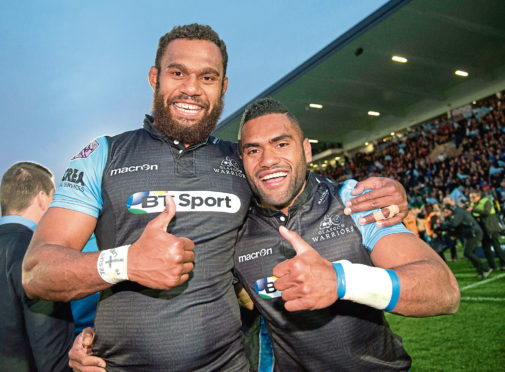In full flow, the Fijian second row Leone Nakarawa is simply the best fun to be had on a rugby pitch.
Sorry to go a bit fanboy on you, but from 2013 to 2016 watching Glasgow was a joy, largely because Nakarawa was on the team. You could literally expect anything when he was on the ball, his addiction to offloading transforming the way the Warriors attacked.
This manifested itself most significantly in the 2015 PRO12 final in Belfast, the biggest game in Glasgow’s history, when Munster were undone by Nakarawa’s athleticism. He set up the first two tries for Rob Harley and DTH van der Merwe, and after that the Irishmen were struggling to keep pace.
But Nakarawa was more than a showman. He lent heft to the Warriors pack – something, as we noted a couple of weeks ago, they’ve been lacking ever since. Plus he was an outstanding setpiece forward, specifically in the lineout.
Nothing much has changed on the field since he left Scotstoun for a sizeable contract buyout (for Glasgow) and salary (for himself) to go to Racing 92 in Paris. But now the Ciel et Blanc have sacked him for returning less than promptly – okay, he was a fortnight late – after the Rugby World Cup.
Glasgow would love to get him back if it can be worked out. I mean, who wouldn’t? Big Naks won European Player of the Year at Racing, and many believe he was more comfortable – and played better – at the Warriors.
But it also panders to a sentimentalism at Glasgow which is questionable to the club’s future development.
The outstanding Glasgow team of 2014 to 2016 was never going to stay together because the club’s success resulted in inflated salariesand star players like Nakarawa, van der Merwe, Niko Matawalu and Ruaridh Jackson departed for more money elsewhere. Ultimately, the club’s most successful development finds, Finn Russell and Stuart Hogg, would depart was well.
This is tough for Glasgow fans to take, but it’s the world in which they – and their rivals at Edinburgh – operate. They cannot match the spending power of the English and French clubs.
Even cases where the contract demands were far from excesssive – one thinks of John Barclay, van der Merwe and Jackson – difficult decisions had to be made to try to keep other stars and stay within budget.
When Dave Rennie took over at Scotstoun, he brought back Jackson, Matawalu and van der Merwe on more attractive terms for the club. Only last week the club re-signed the out of contract Gordon Reid, the Scotland loosehead, on a joint deal with the Ayr Bulls Super6 team.
The response to these returning prodigal sons from the fans has been unanimously ecstatic, and it will be even greater than should Nakarawa come back. But is it good for the team?
The Warriors are a development-based club. It’s what brought them their success chancing their arm on the likes of Russell, who was nobody’s future Scotland stand-off when he was plucked out of club rugby.
And spinning the dice on Nakarawa and Matawalu, neither of whom had played professionally and were really 7s players when Glasgow signed them.
They, successful at the northmost club in Europe, were among those who finally dispelled the old, slightly racist cliche that Islander players were lazy and unreliable.
Continually bringing back former stars to play out the final years of their careers is great PR and goes down a storm with the support. But the hard-nosed decisions and need to develop young players are much more important.
For example, Scott Cummings has come on leaps and bounds in the last year, going from an untried and raw player to a potential future Scotland captain. If Nakawara is brought in for two and a half years, what gives with Cummings, Jonny Gray and Kiran McDonald, who has impressed so much this season?
If money were no object, a long contract for Big Naks – now 30 – would not be an issue. But we’ve yet to see the colour of the promised CVC cash, and this year’s budget has still to be met.
Why the haste?
The review of Scottish Rugby’s structures and governance tabled last week by Sir Bill Gammell and Norman Murray proposes a huge overhaul of the way the SRU is run at board level.
It seems some are mistaken – perhaps misled – on the reasons for the review. Some thought it was as a result of the mishandling of Keith Russell’s departure from Murrayfield as performance director in which CEO Mark Dodson faced widespread criticism.
It was much more because the Dunlop Report, the previous overhaul, was over a decade old and, some thought, needed revising. That’s certainly how Murrayfield consider it.
But why are we doing this so quickly? The present structure may not be entirely ideal but it operates reasonably – there’s no real deadline looming.
Yet the review will be tabled to clubs in four weeks and effectively railroaded through during the Six Nations.
Such a thorough review by Messrs Gammell and Murray requires a much more thorough consultation.
